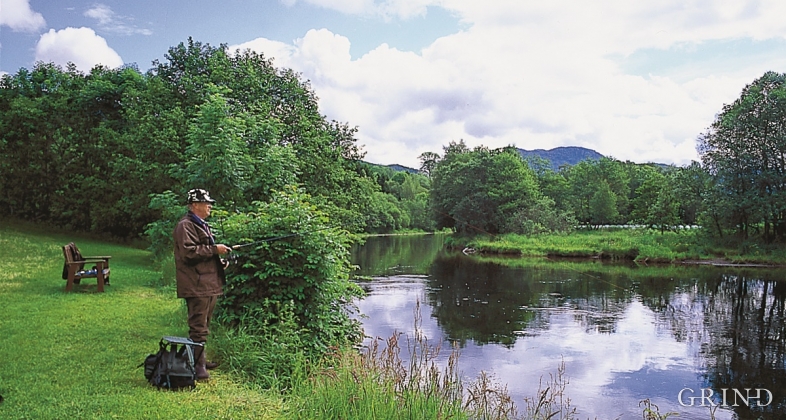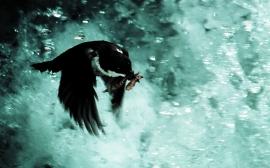Published: 28.10.2004 | Author: Stein Byrkjeland
Fishing in the lower part of Etneelva. (Svein Nord)
BEST SALMON RIVER IN THE COUNTY
There is still life to be found that is just “hanging on a string”. The Etne river has been the most important river for sports- fisherman in Hordaland after salmon fishing in Vosso was temporarily forbidden. As late as 2000, 4 tonnes of salmon and sea trout were taken out of the Etne river, the best fishing for 10 years. In the whole of the county there are only 15-20 rivers that can compete with this haul.
The Etne river - and its branches, the Sør River and Nord River, wind, or "meander", through loose glacial sediments on their journey towards the fjord. The river carves away the sediments in the outer swings and deposits them in the inner swings. Under floods, the mass transport is more effective than usual, and the river can do great damage. There have been been big damaging floods through the ages, last in 1983.
The Etne river is best known for its salmon fishing. The fishing season lasts for about 100 days. The landowners' income from fishing-rentals alone amounts to about 1.5 million Norwegian crowns per year.
In the Etne water system the salmon swim all the up to Frettte. Some even fish for salmon at Øyno. Before a small salmon step was built, it was difficult for the smaller fish to pass Håfoss. Salmon swim also up Sør River to the regulated Lake Litledalsvatnet.
As is also the case in other areas of the country, there has been a decline in fish during past years. The total fish catch has varied from 7.7 tonnes in 1990 down to under 3 tonnes annually. Neither has the Etne river avoided problems with regulation of water levels, salmon lice and runaway aquaculture salmon, but the river still maintains a good, natural growth of salmon.
Golden conditions for the Dipper
The Etne river has a high production of water insects, which, when hatching, provide a good existence for bird species that live a long way from the river. In the stretch of river downstream from Lake Stordalsvatnet, we find the biggest known winter gathering of dippers in Hordaland. Several tens of individuals may be seen together here, preferably in periods of colder weather, when the current isn't so strong and the dipper can effectively hunt for insects on the bottom.
The dipper lives mainly on larvae from the caddisfly and stonefly, but together with the goosander (merganser) and the grey heron they also take a good deal of fish fry. Even so, they do not take more than is tolerated by nature. The dipper is otherwise a hardy fisherman with an unusually compact bone structure that makes him well adapted to life in streams and waterfalls. Each year, many dippers are ringed in Norway. Some of these are found in Southern Sweden and Denmark in winter.
- Bjørklund, A. E. 2002. Vassdrag i Hordaland 2000. Rådgivende Biologer og Fylkesmannen i Hordaland, MVA-rapport 3/2002:1–115.






